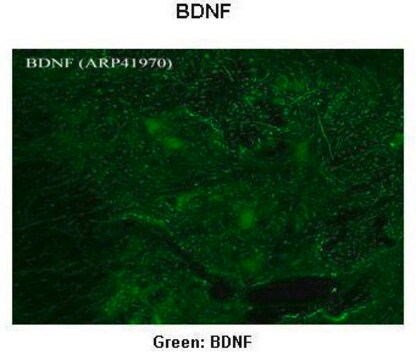추천 제품
생물학적 소스
rabbit
Quality Level
항체 형태
serum
항체 생산 유형
primary antibodies
클론
polyclonal
종 반응성
human
종 반응성(상동성에 의해 예측)
mouse, rat
제조업체/상표
Chemicon®
기술
ELISA: suitable
dot blot: suitable
immunocytochemistry: suitable
immunohistochemistry: suitable
immunoprecipitation (IP): suitable
western blot: suitable
동형
IgG
NCBI 수납 번호
UniProt 수납 번호
배송 상태
wet ice
타겟 번역 후 변형
unmodified
유전자 정보
human ... APP(351)
mouse ... App(11820)
일반 설명
Amyloid monomeric proteins can sometimes oligomerize into destructive amyloid fibrils. Amyloidogenic conformations of non-disease related proteins can be created by partial protein misfolding or denaturation. In disease state oligomerization, extensive amyloid oligomerization creates plaques in neural tissue that correlates with Alzheimer’s symptomology.
특이성
This antibody recognizes generic epitopes common to many amyloid fibrils and fibrillar oligomers, but not monomers, prefibrillar oligomers or natively folded proteins.
면역원
Fibrils prepared from human islet amyloid polypeptide.
애플리케이션
Dot Blot Analysis: 1:1,000 dilution of this antibody detected Amyloid fibrils in fibrils and monomers but not in prefibril oligos. A 1:5,000 dilution, as cited in Glabe C., et al. (2007) Mol Neurodegener 2, 18 shows that the binding with monomers is likely non-specific, and is a possible result of high primary antibody concentration.
This Anti-Amyloid Fibrils LOC Antibody is validated for use in IP, IC, IH, ELISA, WB, DB for the detection of Amyloid Fibrils LOC.
품질
Evaluated by Dot Blot in monomers, prefibril oligos, and fibrils.
Dot Blot Analysis: 1:1,000 dilution of this antibody detected Amyloid fibrils in fibrils and monomers but not in prefibril oligos. A 1:5,000 dilution, as cited in Glabe C., et al. (2007) Mol Neurodegener 2, 18 shows that the binding with monomers is likely non-specific, and is a possible result of high primary antibody concentration.
Dot Blot Analysis: 1:1,000 dilution of this antibody detected Amyloid fibrils in fibrils and monomers but not in prefibril oligos. A 1:5,000 dilution, as cited in Glabe C., et al. (2007) Mol Neurodegener 2, 18 shows that the binding with monomers is likely non-specific, and is a possible result of high primary antibody concentration.
저장 및 안정성
Stable for 1 year at -20°C from date of receipt.
Handling Recommendations: Upon receipt and prior to removing the cap, centrifuge the vial and gently mix the solution. Aliquot into microcentrifuge tubes and store at -20°C. Avoid repeated freeze/thaw cycles, which may damage IgG and affect product performance. After thawing, store at 4°C in 0.02% sodium azide.
Handling Recommendations: Upon receipt and prior to removing the cap, centrifuge the vial and gently mix the solution. Aliquot into microcentrifuge tubes and store at -20°C. Avoid repeated freeze/thaw cycles, which may damage IgG and affect product performance. After thawing, store at 4°C in 0.02% sodium azide.
법적 정보
CHEMICON is a registered trademark of Merck KGaA, Darmstadt, Germany
적합한 제품을 찾을 수 없으신가요?
당사의 제품 선택기 도구.을(를) 시도해 보세요.
Storage Class Code
10 - Combustible liquids
WGK
WGK 1
시험 성적서(COA)
제품의 로트/배치 번호를 입력하여 시험 성적서(COA)을 검색하십시오. 로트 및 배치 번호는 제품 라벨에 있는 ‘로트’ 또는 ‘배치’라는 용어 뒤에서 찾을 수 있습니다.
Juan Jose Ramos-Rodriguez et al.
Molecular neurobiology, 54(5), 3428-3438 (2016-05-15)
Age remains the main risk factor for developing Alzheimer's disease (AD) although certain metabolic alterations, including prediabetes and type 2 diabetes (T2D), may also increase this risk. In order to understand this relationship, we have studied an AD-prediabetes mouse model
Sahil Chandhok et al.
Scientific reports, 13(1), 14471-14471 (2023-09-03)
The formation of protein aggregates is a hallmark of many neurodegenerative diseases and systemic amyloidoses. These disorders are associated with the fibrillation of a variety of proteins/peptides, which ultimately leads to cell toxicity and tissue damage. Understanding how amyloid aggregation
Elin K Esbjörner et al.
Chemistry & biology, 21(6), 732-742 (2014-05-27)
Insight into how amyloid β (Aβ) aggregation occurs in vivo is vital for understanding the molecular pathways that underlie Alzheimer's disease and requires new techniques that provide detailed kinetic and mechanistic information. Using noninvasive fluorescence lifetime recordings, we imaged the formation
Thomas Filip et al.
Alzheimer's research & therapy, 13(1), 175-175 (2021-10-18)
To better understand the etiology and pathomechanisms of Alzheimer's disease, several transgenic animal models that overexpress human tau or human amyloid-beta (Aβ) have been developed. In the present study, we generated a novel transgenic rat model by cross-breeding amyloid precursor
Neuroinflammation and related neuropathologies in APPSL mice: further value of this in vivo model of Alzheimer's disease.
Loffler, T; Flunkert, S; Havas, D; Schweinzer, C; Uger, M; Windisch, M; Steyrer, E; Hutter-Paier, B
Journal of Neuroinflammation null
자사의 과학자팀은 생명 과학, 재료 과학, 화학 합성, 크로마토그래피, 분석 및 기타 많은 영역을 포함한 모든 과학 분야에 경험이 있습니다..
고객지원팀으로 연락바랍니다.







